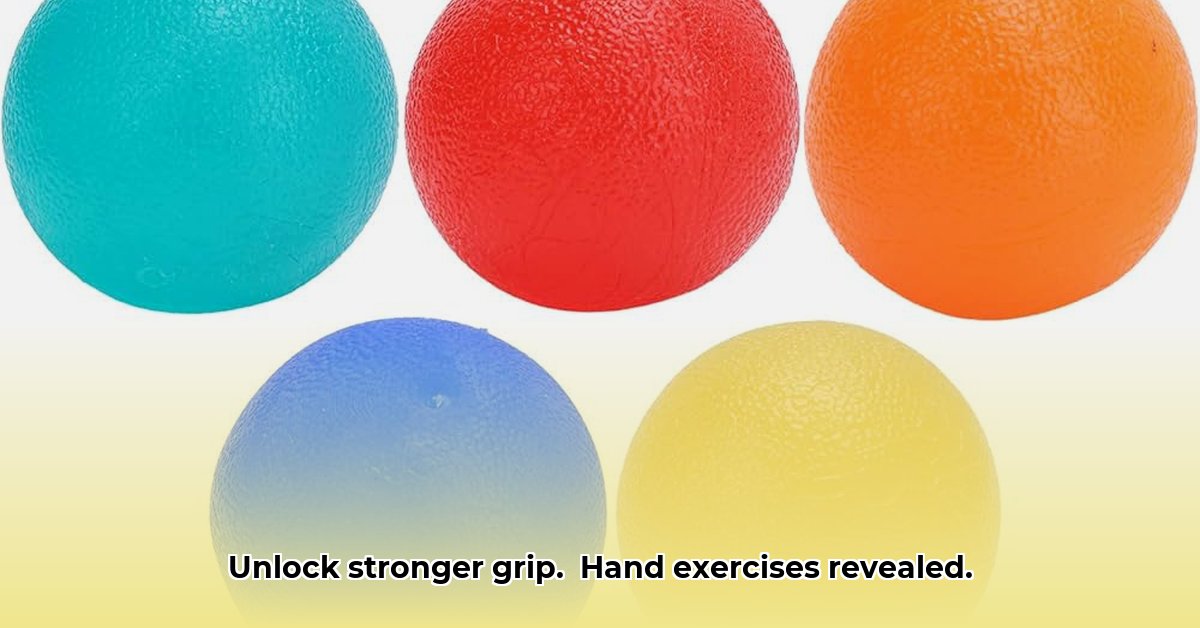Is hand pain or weakness holding you back? From opening jars to typing emails, healthy hands are crucial for daily life. A hand exercise ball offers a simple yet powerful way to improve grip strength, boost dexterity, and alleviate discomfort. Whether you’re a beginner, an athlete, or managing conditions like arthritis or carpal tunnel syndrome, this guide provides comprehensive information to help you choose the right ball and master effective exercises for optimal hand health.
The Power of Hand Exercise Balls: Your Path to Stronger, Healthier Hands
Hand exercise balls, also known as stress balls or grip strengtheners, are more than just stress relievers. They’re versatile tools that can significantly improve your hand health. These unassuming devices are ideal for anyone seeking stronger, more flexible hands. They’re particularly beneficial for:
- Older adults: Combating age-related stiffness and maintaining hand function.
- Athletes: Enhancing grip strength for sports like tennis, golf, and rock climbing.
- Individuals recovering from injuries: Aiding in rehabilitation after surgery, fractures, or sprains.
- People with arthritis or carpal tunnel syndrome: Easing pain, stiffness, and improving range of motion.
- Anyone seeking a better grip: Improving everyday tasks and hobbies.
Getting Started: Maximizing Your Hand Exercise Ball Workout
Ready to experience the benefits of hand exercise balls? These exercises are easy to learn and can be adapted to your current fitness level. Remember to listen to your body. If you feel pain, stop immediately. Begin slowly and gradually increase the intensity and duration of your workouts. Aim for consistency over intensity.
Essential Exercises:
1. The Basic Squeeze:
- Hold the exercise ball in one hand.
- Squeeze the ball as firmly as comfortably possible, avoiding any strain.
- Maintain the squeeze for approximately 5-10 seconds.
- Slowly and deliberately release your grip.
- Repeat this exercise 10-15 times before switching to the other hand.
2. The Finger Pinch:
- Position the ball between your thumb and fingers.
- Pinch the ball with a firm but controlled motion. Focus on using your fingertips.
- Hold this pinch for 5-10 seconds.
- Release the pressure.
- Repeat the pinch 10-15 times, and then switch to the opposite hand.
3. The Palm Roll:
- Place the ball on a flat, stable surface like a table.
- Employ your fingers and thumb to roll the ball around. Maintain smooth, controlled movements.
- Continue rolling the ball for roughly a minute.
- Switch hands and repeat the exercise.
4. Advanced Techniques (Increasing Intensity):
- Rapid Squeezes: Squeeze and quickly release the ball, focusing on speed and repetition.
- Isometric Holds: Hold the squeeze at maximum comfortable intensity for an extended period (15-30 seconds). This strengthens the muscles through sustained contraction.
- Targeted Grips: Experiment with different grips – using only your fingers, or just your thumb and index finger to target specific muscle groups in the hand and forearm.
- Varying Resistance: As your hand strength improves, switch to a ball with higher resistance to continue challenging your muscles.
Choosing the Perfect Hand Exercise Ball: A Buyer’s Guide
Not all hand exercise balls are created equal. Selecting the right ball is crucial for an effective and comfortable workout.
- Resistance Level: Selecting the correct resistance is key. If you’re just starting or recovering from an injury, opt for a low-resistance (extra-soft or soft) ball. As your hand strength increases, progress to a medium or firm resistance ball. Many products will list the resistance in pounds or kilograms, allowing for a more precise selection.
- Material Composition: Most hand exercise balls are made from rubber, silicone, or thermoplastic elastomer (TPE). TPE is a popular choice due to its durability, elasticity, and hypoallergenic properties. Look for latex-free options if you have a latex allergy.
- Size and Shape: A standard-sized ball (around 5cm in diameter) is suitable for most adult hands. However, if you have smaller hands or limited mobility, a smaller ball may be more comfortable and effective. Consider egg-shaped or oval balls for a more ergonomic grip.
- Texture: Some balls have a smooth surface, while others have a textured surface for enhanced grip. Choose a texture that feels comfortable and secure in your hand.
- Durability: Look for balls made from high-quality materials that can withstand repeated use without losing their shape or resistance. Read reviews to gauge the durability of different brands and models.
Unlocking the Benefits: Therapeutic Uses of Hand Therapy
Using a hand exercise ball regularly offers a wide range of benefits, including:
- Increased Grip Strength: Noticeable improvement in your ability to hold and manipulate objects.
- Improved Finger Dexterity: Enhanced coordination and precision in finger movements, beneficial for tasks like typing, playing musical instruments, and crafting.
- Expanded Range of Motion: Increased flexibility in your hands and wrists, reducing stiffness and improving overall mobility.
- Arthritis Pain Relief: Regular exercise can alleviate stiffness and pain associated with arthritis by improving circulation and lubricating joints. (Note: Consult your doctor or physical therapist for personalized recommendations.)
- Carpal Tunnel Syndrome Relief: Reduce pressure on the median nerve and alleviate symptoms like numbness, tingling, and pain. (Note: Hand exercise balls are not a substitute for medical treatment for carpal tunnel syndrome.)
- Stress Reduction: Squeezing a hand exercise ball can be a calming and grounding activity, helping to relieve stress and tension.
- Improved Circulation: Stimulating blood flow to the hands and fingers, promoting healing and reducing inflammation.
Prioritizing Safety: Preventing Injuries During Hand Workouts
Safety should always be your top priority when using a hand exercise ball.
- Listen to Your Body’s Signals: If you experience any pain, stop the exercise immediately. Pushing yourself too hard can lead to injuries.
- Start Slowly and Gradually Increase: Begin with low-resistance exercises and gradually increase the intensity and duration as your strength improves. Avoid attempting advanced exercises before you are ready.
- Check for Allergies Before Use: Examine the packaging to ensure you are not allergic to any of the materials used in the ball’s construction.
- Avoid Overexertion: Applying excessive force can harm your hands. Concentrate on gentle strength development.
- Proper Form: Ensure you are using the correct form for each exercise to avoid strain or injury. Watch videos or consult with a physical therapist if you are unsure.
- Warm-up: Before starting your hand exercises, warm up your hands and wrists with gentle stretches and range-of-motion exercises.
- Cool-down: After your workout, cool down with gentle stretches to improve flexibility and reduce muscle soreness.
The Future of Hand Exercise Balls: Innovation and Advancements
The market for hand exercise balls is continuously evolving, driven by the demand for more effective and user-friendly products.
- Standardization of Resistance Levels: Efforts are underway to establish consistent standards for resistance levels across different brands, providing consumers with more reliable information.
- Advanced Materials: Expect to see the development of more durable, comfortable, and eco-friendly materials.
- Smart Technology Integration: Future innovations may include “smart” balls equipped with sensors that track your progress, provide real-time feedback, and personalize your workouts.
- Personalized Exercise Programs: Apps and online platforms may offer customized exercise programs based on your individual needs and goals.
- Improved Ergonomics: Expect to see more ergonomic designs that fit comfortably in the hand and reduce the risk of strain.
- Greater Transparency: Consumers are demanding more transparency from manufacturers regarding materials, manufacturing processes, and product testing.
Maximizing Your Success: Additional Tips for Hand Fitness
- Consistency is Key: Regular, short sessions are more effective than infrequent, intense workouts. Aim for at least 10-15 minutes of exercise, 3-5 times per week.
- Make it a Habit: Integrate hand exercises into your daily routine, such as while watching TV, waiting in line, or during breaks at work.
- Combine with Other Therapies: Enhance the benefits of hand exercise balls by combining them with other hand therapy techniques, such as finger stretches, massage, and heat or cold therapy.
- Stay Hydrated: Drinking plenty of water helps keep your muscles and joints lubricated, reducing the risk of stiffness and pain.
- Listen to Your Body: Pay attention to any pain or discomfort and adjust your exercises accordingly.
- Consult a Professional: If you have any underlying medical conditions or are experiencing significant hand pain, consult with a doctor or physical therapist for personalized guidance.
A hand exercise ball is a powerful and accessible tool for improving hand health, strength, and overall well-being. By using it correctly and consistently, you can experience significant benefits in your daily life. Remember to listen to your body, prioritize safety, and enjoy the process of strengthening your grip!
- Achieve Anesthesiology Work-Life Balance: Your Guide - December 4, 2025
- Unlock Young Doctors’ Work-Life Balance: Actionable Strategies Now - December 2, 2025
- Unlock Life Harmony: Work-Life Integration Guide - November 30, 2025
















